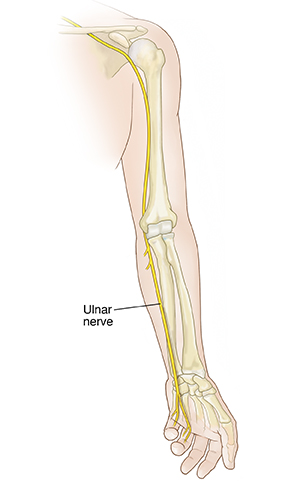The ulnar nerve travels down the arm from the shoulder to the hand. It controls movement and feeling in the forearm, wrist, hand, and fingers. Damage to this nerve can cause a condition called ulnar nerve palsy.
The elbow is the most common site of compression. A common cause of ulnar nerve palsy is leaning on the elbow for a prolonged period. Injury to the arm, wrist, or elbow, such as a fracture, can also damage the ulnar nerve.
Symptoms of ulnar nerve palsy usually start slowly unless it is associated with trauma. They include:
-
Numbness, tingling, or burning (often described as pins and needles).
-
Pain is most often present if there is an acute injury
-
Weakness or muscle shrinking in the hand and fingers
Treatment depends on the cause of the nerve damage. In some cases, the problem will go away on its own once pressure to the nerve is relieved.
Certain tests may be done to help determine the location of the injury and extent of damage. These include nerve conduction studies (NCS), electromyography (EMG), and ultrasound.
For patients with mild to moderate symptoms, conservative treatment can be administered. Splinting the wrist or elbow to limit movement may help with healing. If the problem is due to trauma or injury, physical therapy may be prescribed. Corticosteroid injections may sometimes be given into the area to reduce swelling and pressure on the nerve.
Surgery to repair the nerve may be needed for chronic symptoms that don't respond to simpler treatments.
Home care
-
Rest the wrist and arm until normal feeling and strength return.
-
If you were given a splint or sling, wear it as directed.
-
Don't lean on your elbows.
-
Talk to your physical therapist about modifying certain activities that cause compression of your ulnar nerve.
-
Consider wearing elbow pads to protect the nerve.
-
If medicines were prescribed for pain or nerve sensations, take them as directed.
Follow-up care
Follow up with your healthcare provider or as advised by the staff.
When to get medical advice
Call your healthcare provider or seek medical care right away if you have any of the following:
-
Increasing arm swelling or pain
-
Numbness or weakness of the arm
Call 911
Call 911 if any of these occur:
-
Symptoms spread to other parts of the body
-
Slurred speech, confusion
-
Trouble speaking, walking, or seeing


